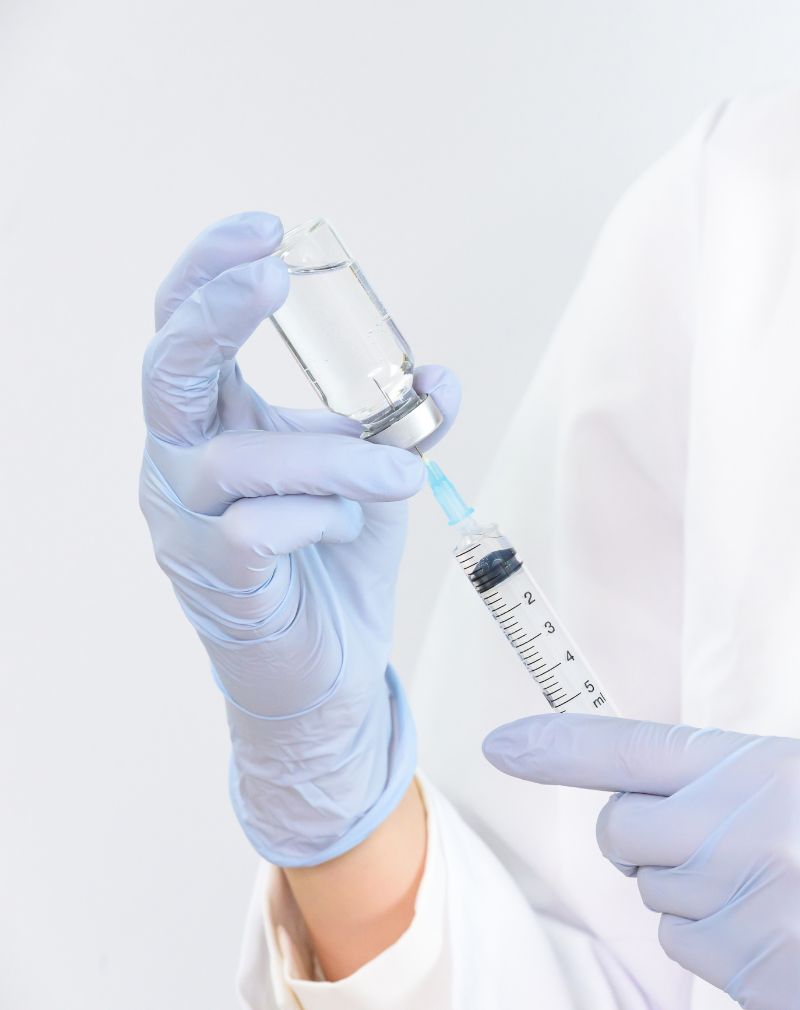Picture this: You’re out with friends at a charming café in Dubai, savoring a rich, velvety cheesecake or a perfectly frothed latte. But within an hour, discomfort sets in. Bloating, stomach cramps, and an unsettling nausea take over, making you wonder if dairy could be the culprit.
Lactose intolerance is more common than many realize, yet it remains one of the most misunderstood dietary conditions. Affecting millions worldwide, it occurs when the body lacks enough lactase, the enzyme needed to break down lactose, the natural sugar in dairy. While some may dismiss it as a minor inconvenience, for many, it can disrupt daily life, causing digestive distress and limiting food choices.
In diverse and cosmopolitan regions like Dubai, where global cuisines and dairy-rich foods are abundant, managing lactose intolerance requires awareness and the right guidance. At The American Wellness Center in Dubai Healthcare City, our Allergy and Immunology specialists help individuals identify food intolerances, develop tailored nutritional strategies, and regain control over their well-being without completely giving up the foods they love.
Understanding lactose intolerance is the first step to living comfortably with it. In this blog, we will explore what causes it, how to recognize its symptoms, and the best ways to manage it while maintaining a balanced and satisfying diet.
What is Lactose Intolerance?
Lactose is a natural sugar found in milk and dairy products, giving them their slightly sweet taste. For the body to digest lactose properly, it relies on an enzyme called lactase, which breaks lactose down into simpler sugars that can be easily absorbed.
Lactose intolerance occurs when the body does not produce enough lactase, leading to undigested lactose passing through the digestive system. This can cause bloating, gas, stomach cramps, and diarrhea, as the undigested lactose ferments in the colon. The severity of symptoms varies from person to person, depending on how much lactase their body produces.
Lactose Intolerance vs. Milk Allergy
Although often confused, lactose intolerance and milk allergy are two very different conditions.
- Lactose intolerance is a digestive issue caused by an enzyme deficiency. It results in gastrointestinal discomfort but does not involve the immune system.
- Milk allergy is an immune system reaction to proteins in milk, such as casein or whey. Symptoms can range from hives and swelling to severe allergic reactions, including anaphylaxis.
While lactose intolerance is uncomfortable, it is not life-threatening. Milk allergy, on the other hand, can be dangerous and requires strict avoidance of all dairy products.
Myths vs. Facts About Lactose Intolerance
- Myth: Lactose intolerance means you can never eat dairy again.
- Fact: Many people with lactose intolerance can tolerate small amounts of dairy or lactose-free alternatives. Some hard cheeses and yogurts contain little lactose and are easier to digest.
- Myth: Only adults develop lactose intolerance.
- Fact: While some infants are born with lactose intolerance, it is more commonly developed in adolescence or adulthood as lactase production naturally declines.
- Myth: Lactose intolerance is the same for everyone.
- Fact: The level of lactase deficiency varies. Some individuals can tolerate a glass of milk, while others react to even small amounts of lactose.
Understanding the difference between myths and facts helps individuals make informed choices about their diet and lifestyle. With the right adjustments and the right guidance particularly from centers like ours i.e. The American Wellness Center in Dubai Healthcare City, lactose intolerance does not have to mean giving up all dairy.
Recognizing the Symptoms
Lactose intolerance can manifest in different ways, depending on the individual’s level of lactase deficiency. While digestive issues are the most common, some people also experience symptoms that go beyond the gut.
Digestive Symptoms
Since lactose intolerance primarily affects the digestive system, symptoms often appear within 30 minutes to two hours after consuming dairy. These include:
- Bloating and excessive gas
- Stomach cramps or abdominal pain
- Diarrhea or loose stools
- Nausea, sometimes accompanied by vomiting
The severity of these symptoms depends on how much lactose was consumed and how little lactase the body produces. Some individuals may tolerate small amounts of dairy, while others experience discomfort even with minimal lactose intake.
Non-Digestive Symptoms
While lactose intolerance is typically associated with digestive distress, some people report additional symptoms that may not seem directly linked to dairy consumption. These can include:
- Headaches or migraines
- Fatigue and brain fog
- Skin issues such as eczema or rashes
The connection between lactose intolerance and these non-digestive symptoms is still being studied, but they may result from inflammation or gut imbalances caused by undigested lactose.
Variability in Symptoms
Not everyone with lactose intolerance experiences the same symptoms or severity. Some can enjoy small amounts of dairy without issues, while others react to even trace amounts. This variability makes it important to recognize personal tolerance levels and adjust dietary habits accordingly.
Diagnosis and Testing
For those who suspect they may be lactose intolerant, proper testing is essential to confirm the condition and rule out other gastrointestinal disorders. Self-diagnosing based on symptoms alone can be misleading, as conditions like irritable bowel syndrome (IBS) or milk allergies can present with similar digestive issues. Seeking a professional diagnosis ensures accurate results and the right approach to management.
Lactose Tolerance Test
- Involves drinking a liquid containing lactose.
- Blood sugar levels are monitored over time.
- A lack of rise in blood sugar indicates improper lactose digestion.
Hydrogen Breath Test
- Measures hydrogen levels in the breath after consuming lactose.
- High hydrogen levels suggest undigested lactose is fermenting in the colon.
- A widely used and non-invasive diagnostic method.
Stool Acidity Test
- Measures lactic acid and fatty acids in the stool, which indicate undigested lactose.
- Useful when blood or breath tests are not feasible.
Why a Professional Diagnosis is Important
Lactose intolerance shares symptoms with other digestive conditions, such as:
- Irritable Bowel Syndrome (IBS): Can cause bloating, cramps, and diarrhea, often triggered by stress or certain foods.
- Milk Allergy: An immune reaction to proteins in milk that can cause skin rashes, respiratory issues, and digestive problems.
- Small Intestinal Bacterial Overgrowth (SIBO): Can lead to bloating and diarrhea due to bacterial fermentation of undigested carbohydrates.
Since dietary restrictions can impact long-term nutrition, it is crucial to determine whether lactose intolerance is the true cause of symptoms before making drastic dietary changes.
Comprehensive Testing at The American Wellness Center
At The American Wellness Center in Dubai Healthcare City, specialists in Allergy and Immunology provide accurate and thorough testing for lactose intolerance and other food sensitivities. Using state-of-the-art diagnostic tools, they help patients understand their condition and develop tailored dietary plans to manage symptoms without unnecessary food restrictions.
A proper diagnosis is the first step toward managing lactose intolerance effectively and ensuring a balanced, nutritious diet.
Managing and Living with Lactose Intolerance
Lactose intolerance does not mean completely giving up dairy or struggling with discomfort after every meal. With the right dietary adjustments and awareness, individuals can manage their symptoms while maintaining a balanced and fulfilling diet.
Making Smart Dietary Adjustments
The first step in managing lactose intolerance is identifying sources of lactose in the diet. While milk, cheese, and yogurt are obvious sources, lactose is also found in unexpected places such as:
- Processed foods like bread, cereal, and snack bars
- Sauces and dressings, including salad dressings and creamy soups
- Medications and supplements, where lactose is sometimes used as a filler
Switching to lactose-free or dairy-free alternatives can help. Many supermarkets in Dubai offer a variety of options, including:
- Plant-based milk such as almond, soy, oat, or coconut milk
- Lactose-free dairy products, which contain added lactase to aid digestion
- Aged cheeses, like cheddar or parmesan, which have lower lactose levels
- Yogurts with live cultures, as probiotics can aid lactose digestion
For those who still want to enjoy regular dairy, lactase enzyme supplements can help break down lactose, reducing digestive discomfort. These can be taken before consuming dairy-containing foods, making it easier to enjoy occasional treats without symptoms.
Maintaining Proper Nutrition
Avoiding dairy can lead to deficiencies in calcium, vitamin D, and probiotics, which are essential for bone health and digestion. To compensate, consider:
- Calcium-rich foods such as leafy greens, almonds, and fortified plant-based milk
- Vitamin D sources like fatty fish, eggs, and sun exposure
- Probiotics from fermented foods like kimchi, miso, and dairy-free yogurts
Practical Tips for Everyday Living
- Ask about lactose-free or dairy-free options at restaurants. Many places accommodate dietary restrictions, especially in Dubai’s diverse food scene.
- Opt for dishes with minimal dairy, such as grilled meats, salads with vinaigrette, or coconut-based curries.
- Look for terms like milk solids, whey, casein, and lactose, which indicate dairy content.
- Many products now label themselves as lactose-free, making it easier to choose safe options.
- Middle Eastern cuisine offers naturally lactose-free options like hummus, falafel, grilled meats, and rice dishes.
- Traditional dairy-heavy dishes, such as labneh or milk-based desserts, may have dairy-free alternatives available.
- Stock up on lactose-free staples, including plant-based milk, dairy-free cheese, and calcium-rich foods.
- Plan meals in advance to ensure a well-rounded diet that does not rely on dairy for essential nutrients.
Seeking Professional Help: Taking Control of Your Health
Lactose intolerance may seem manageable through trial and error, but without proper guidance, it can lead to unnecessary dietary restrictions, nutritional deficiencies, and ongoing discomfort. If you find yourself frequently experiencing digestive distress after consuming dairy, it may be time to consult a specialist.
An allergist can help confirm whether your symptoms stem from lactose intolerance, a milk allergy, or another underlying digestive condition, ensuring that you receive the correct diagnosis. A nutritionist can then guide you in creating a balanced diet that supports your overall health without unnecessary food restrictions.
At The American Wellness Center in Dubai Healthcare City, our team of Allergy and Immunology specialists provides comprehensive food intolerance testing, expert dietary counseling, and personalized management plans. Whether you need help identifying safe foods, finding alternatives, or understanding how to maintain optimal nutrition, we offer the support you need to live comfortably and confidently.
Lactose intolerance does not have to limit your lifestyle. With the right knowledge and professional guidance, you can continue to enjoy delicious, nutritious meals without discomfort. Schedule a consultation at The American Wellness Center today and take the first step toward better digestive health. Contact Us Today!



